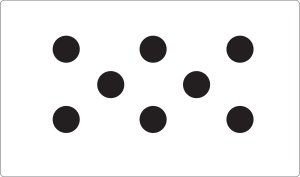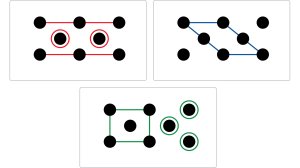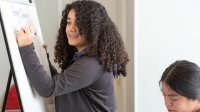Rough Draft Thinking Can Make Math Class More Inclusive
When math lessons emphasize collaboration and exploration over performance, students become more engaged and confident math thinkers.
Your content has been saved!
Go to My Saved Content.Writing, discussing, and revising rough drafts is standard practice in language arts classes. But to Amanda Jansen, a junior high math teacher, author, and professor at the University of Delaware’s School of Education, “rough draft thinking” is also a powerful tool for making the math classroom an inclusive, engaging place of shared exploration where students feel comfortable thinking aloud as they problem-solve.
Producing rough drafts of math problems, and discussing them in class, is “liberating for students because they can start to see how they’re contributing to their colleagues’ learning in a lot of different ways,” Jansen says in an interview with KQED’s MindShift. “After the initial shift, [students] start to get more excited, like, ‘Wow, my ideas actually matter.’ Everyone feels included in that kind of environment.”
When the focus of math class evolves from emphasizing right or wrong answers—and the frequently public judgement that accompanies that high-stakes style of learning—to a collaborative environment where kids feel motivated to explore and take risks, students respond by becoming more engaged and confident about sharing their ideas. “[Students] show up with this sense of just feeling happy to be there,” says Jansen. “They are more likely to just put something out there, whether it’s in the group work or coming up to the document camera to share their thinking. They tend to feel proud.”
Putting rough draft math into practice
When Christine Hubbard, a math teacher in Middletown, Delaware, uses rough draft thinking with her seventh-grade students, she defines the process briefly for her students and then moves directly into a number talk during which she explains the lesson—in this case: visualizing how to chunk sets of dots to make sets easier to count. Then Hubbard briefly shows her students a domino-like figure and asks them how many dots they see.

“I want you, in your mind, to be thinking about how many dots there are,” she says to the class. All her students report seeing eight dots.
Hubbard steers the conversation toward examining students’ strategies with questions like “Can anyone be brave enough to share and justify why they think there’s eight dots up there?” On a whiteboard—or using Google Slides during synchronous learning—one student draws a set of five dots, like the side of a dice, plus a group of three dots; another student draws two horizontal lines of three dots and an additional two in the middle; and yet another draws a shape that loosely resembles a diamond composed of six dots.

Students discuss what to call the diamond-like shape: maybe a “thingy,” suggests one student or a “weird rectangle,” says another. “Yes, you could describe it that way,” Hubbard encourages. Finally, a student suggests that because the shape has two pairs of parallel sides, it could be a parallelogram. Hubbard confirms that yes, it is indeed a parallelogram. Guided by Hubbard, and with multiple students contributing ideas along the way and engaging in the type of verbal exploration that helps learners absorb and connect mathematical concepts, the class arrived at the "correct" answer.
Rough draft thinking can engage more students
Incorporating rough draft thinking into an existing math curriculum can feel like a big lift, but Jansen says the investment pays off: the practice winds up becoming more efficient over time as teachers become more adept at building in revision expectations and experiences.
Getting frustrated students to re-engage with mathematics, after all, is “not as simple as making problems relevant, or connecting them to the real world,” writes K-12 math and science coordinator Matthew Beyranevand. “To get students interested in math, we need to provide opportunities for students to authentically inquire. We want kids—not the textbook or the teacher—to ask the questions.”
That’s where Jansen says framing math as a shared exploration comes into play, giving more students a chance to contribute to collective problem-solving and communal understanding of mathematical concepts. When “everyone’s ideas have strengths in them and the teacher points out what’s valuable about the drafts, and [students’] peers start to point out what’s valuable, then everyone is seeing each other as having some mathematical strengths,” Jansen suggests.
It also provides teachers with the opportunity to be more intentional about helping students, who are often riddled with math anxiety and lack confidence in the subject, see themselves as mathematicians. Math is “plagued by stereotypes and many students think math isn’t for people who look like them,” writes high school math teacher Dylan Kane. “As a math teacher, it’s my responsibility to offer counternarratives that help students see themselves as mathematicians and expand what they think it means to ‘do mathematics’.”
Keeping track of who is being called on in class is critical here so that teachers aren’t inadvertently creating new equity dilemmas by positioning the same group of students—girls or Black or LatinX students, for example—as only capable of presenting work that’s rough, versus others being consistently recognized for work that’s more developed. Refined and brilliant thinking, Jansen says, can come from any student. “We need to make sure not only are [diverse students] having a voice, but their strengths are being really looked at,” she says.
For shy, quiet kids who might prefer to keep their math thinking to themselves, Jansen gently challenges them to share in class. She also likes to offer opportunities for writing—usually when the class is working on revision—as a low-stakes way for introverted kids to participate. “Every time we’re being asked to articulate our thinking, we make new connections or crystallize our ideas just by trying to put them into words or into writing,” Jansen says.
